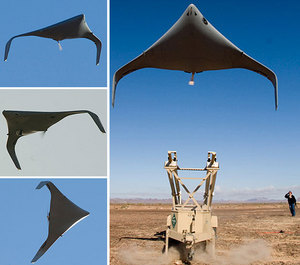Boeing, which is protesting its $35 billion loss to Airbus parent EADS on a refueling plane contract, currently has a lock on small, portable Marine and Navy UAVs used for recon missions. The company's ScanEagle first placed into Marine hands four years ago, when the Pentagon decided that they were vital for combat in Iraq and Afghanistan. A year later the Navy purchased more to provide over-the-horizon monitoring of oil platforms and suspicious ships. (A nearly identical ScanEagle model is making its way into U.S. police departments.) To cover these purchases, the Pentagon crafted a non-competitive order - permitted when an item is designated as an "urgent operational requirement" - with Boeing and aerospace design firm Insitu, in July 2004.

|
| ©Raytheon Co |
| Killer Bee UAV |
But now a full-scale military auction is on, and Raytheon has revealed its own battle-ready contender, the Killer Bee, exclusively to PopularMechanics.com nearly a week before its unveiling at the Navy League's 2008 Sea-Air-Space Exposition. We've seen test footage of the blended-wing aircraft before Swift Engineering teamed up with Raytheon, but these detailed new images - 5-ft. curved wings and all - show an updated model ready for sale, and hoping to knock ScanEagle out of the Navy and Marine inventory.
The Small Tactical Unmanned Aircraft System program is seeking to field a system that can stay aloft for 10 to 24 hours, takeoff from a mobile catapult-style launcher, land without a runway, navigate on its own, and have several UAVs controllable from a single platform. The ScanEagle fleet already fulfills many of these requirements, and steady upgrades and a battle-tested track record should make the trailblazing UAV competitive against new designs.
Raytheon, however, says the militarized Killer Bee has more room for payloads and more than 100 miles of range, plus the ability to track objects day or night with video and infrared feeds, and guide precision munitions with an on-board laser designator. The new turn-down wings help to accommodate antennae and improve yaw stability (i.e. smooth turns.)
The military's final decision is scheduled for June or July, with first fielding in 2011. But stay tuned March 18 to 20 for live coverage from the Sea-Air-Space Expo right here.



Reader Comments
to our Newsletter